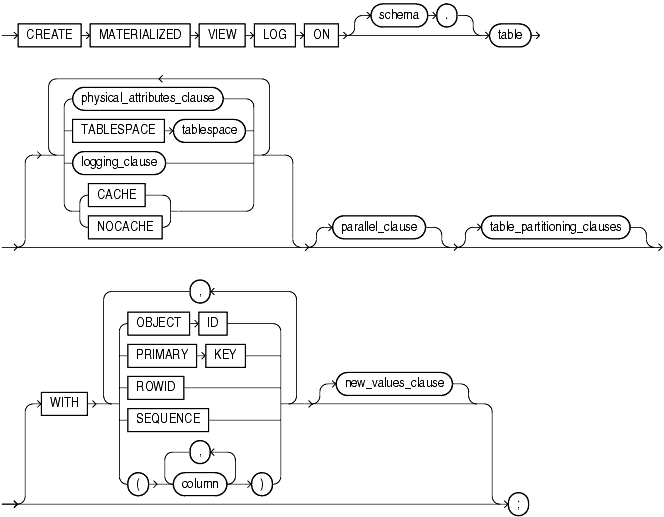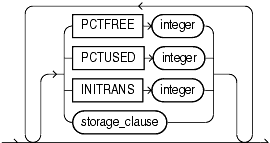| Oracle® Database SQL Reference 10g Release 1 (10.1) Part Number B10759-01 |
|
|
View PDF |
| Oracle® Database SQL Reference 10g Release 1 (10.1) Part Number B10759-01 |
|
|
View PDF |
Purpose
Use the CREATE MATERIALIZED VIEW LOG statement to create a materialized view log, which is a table associated with the master table of a materialized view.
|
Note: The keywordSNAPSHOT is supported in place of MATERIALIZED VIEW for backward compatibility. |
When DML changes are made to master table data, Oracle Database stores rows describing those changes in the materialized view log and then uses the materialized view log to refresh materialized views based on the master table. This process is called incremental or fast refresh. Without a materialized view log, Oracle Database must reexecute the materialized view query to refresh the materialized view. This process is called a complete refresh. Usually, a fast refresh takes less time than a complete refresh.
A materialized view log is located in the master database in the same schema as the master table. A master table can have only one materialized view log defined on it. Oracle Database can use this materialized view log to perform fast refreshes for all fast-refreshable materialized views based on the master table.
To fast refresh a materialized join view, you must create a materialized view log for each of the tables referenced by the materialized view.
|
See Also:
|
Prerequisites
The privileges required to create a materialized view log directly relate to the privileges necessary to create the underlying objects associated with a materialized view log.
If you own the master table, you can create an associated materialized view log if you have the CREATE TABLE privilege.
If you are creating a materialized view log for a table in another user's schema, you must have the CREATE ANY TABLE and COMMENT ANY TABLE system privileges, as well as either the SELECT object privilege on the master table or the SELECT ANY TABLE system privilege.
In either case, the owner of the materialized view log must have sufficient quota in the tablespace intended to hold the materialized view log or must have the UNLIMITED TABLESPACE system privilege.
|
See Also: Oracle Data Warehousing Guide for more information about the prerequisites for creating a materialized view log |
Syntax

(physical_attributes_clause::=, logging_clause::=, parallel_clause::=, table_partitioning_clauses ::= (in CREATE TABLE), new_values_clause::=)




Semantics
Specify the schema containing the materialized view log master table. If you omit schema, then Oracle Database assumes the master table is contained in your own schema. Oracle Database creates the materialized view log in the schema of its master table. You cannot create a materialized view log for a table in the schema of the user SYS.
Specify the name of the master table for which the materialized view log is to be created.
You cannot create a materialized view log for a temporary table or for a view.
Use the physical_attributes_clause to define physical and storage characteristics for the materialized view log.
|
See Also: physical_attributes_clause and storage_clause for a complete description these clauses, including default values |
Specify the tablespace in which the materialized view log is to be created. If you omit this clause, then the database creates the materialized view log in the default tablespace of the schema of the materialized view log.
Specify either LOGGING or NOLOGGING to establish the logging characteristics for the materialized view log. The default is the logging characteristic of the tablespace in which the materialized view log resides.
For data that will be accessed frequently, CACHE specifies that the blocks retrieved for this log are placed at the most recently used end of the least recently used (LRU) list in the buffer cache when a full table scan is performed. This attribute is useful for small lookup tables.
NOCACHE specifies that the blocks are placed at the least recently used end of the LRU list. The default is NOCACHE.
|
Note: NOCACHE has no effect on materialized view logs for which you specify KEEP in the storage_clause. |
The parallel_clause lets you indicate whether parallel operations will be supported for the materialized view log.
For complete information on this clause, please refer to parallel_clause in the documentation on CREATE TABLE.
Use the table_partitioning_clauses to indicate that the materialized view log is partitioned on specified ranges of values or on a hash function. Partitioning of materialized view logs is the same as partitioning of tables.
Use the WITH clause to indicate whether the materialized view log should record the primary key, rowid, object ID, or a combination of these row identifiers when rows in the master are changed. You can also use this clause to add a sequence to the materialized view log to provide additional ordering information for its records.
This clause also specifies whether the materialized view log records additional columns that might be referenced as filter columns, which are non-primary-key columns referenced by subquery materialized views, or join columns, which are non-primary-key columns that define a join in the subquery WHERE clause.
If you omit this clause, or if you specify the clause without PRIMARY KEY, ROWID, or OBJECT ID, then the database stores primary key values by default. However, the database does not store primary key values implicitly if you specify only OBJECT ID or ROWID at create time. A primary key log, created either explicitly or by default, performs additional checking on the primary key constraint.
Specify OBJECT ID to indicate that the system-generated or user-defined object identifier of every modified row should be recorded in the materialized view log.
You can specify OBJECT ID only when creating a log on an object table, and you cannot specify it for storage tables.
Specify PRIMARY KEY to indicate that the primary key of all rows changed should be recorded in the materialized view log.
Specify ROWID to indicate that the rowid of all rows changed should be recorded in the materialized view log.
Specify SEQUENCE to indicate that a sequence value providing additional ordering information should be recorded in the materialized view log. Sequence numbers are necessary to support fast refresh after some update scenarios.
|
See Also: Oracle Data Warehousing Guide for more information on the use of sequence numbers in materialized view logs and for examples that use this clause |
Specify the columns whose values you want to be recorded in the materialized view log for all rows that are changed. Typically these columns are filter columns and join columns.
You can specify only one PRIMARY KEY, one ROWID, one OBJECT ID, one SEQUENCE, and one column list for each materialized view log.
Primary key columns are implicitly recorded in the materialized view log. Therefore, you cannot specify either of the following combinations if column contains one of the primary key columns:
WITH ... PRIMARY KEY ... (column) WITH ... (column) ... PRIMARY KEY WITH (column)
|
See Also:
|
The NEW VALUES clause lets you determine whether Oracle Database saves both old and new values for update DML operations in the materialized view log.
Specify INCLUDING to save both new and old values in the log. If this log is for a table on which you have a single-table materialized aggregate view, and if you want the materialized view to be eligible for fast refresh, then you must specify INCLUDING.
Specify EXCLUDING to disable the recording of new values in the log. This is the default. You can use this clause to avoid the overhead of recording new values. Do not use this clause if you have a fast-refreshable single-table materialized aggregate view defined on the master table.
The following statement creates a materialized view log on the oe.customers table that specifies physical and storage characteristics:
CREATE MATERIALIZED VIEW LOG ON customers PCTFREE 5 TABLESPACE example STORAGE (INITIAL 10K NEXT 10K);
This materialized view log supports fast refresh for primary key materialized views only. The following statement creates another version of the materialized view log with the ROWID clause, which enables fast refresh for more types of materialized views:
CREATE MATERIALIZED VIEW LOG ON customers WITH PRIMARY KEY, ROWID;
This materialized view log makes fast refresh possible for rowid materialized views and for materialized join views. To provide for fast refresh of materialized aggregate views, you must also specify the SEQUENCE and INCLUDING NEW VALUES clauses, as shown in the next statement.
The following statement creates a materialized view log on the sh.sales table and is used in "Creating Materialized Aggregate Views: Example". It specifies as filter columns all of the columns of the table referenced in that materialized view.
CREATE MATERIALIZED VIEW LOG ON sales WITH ROWID, SEQUENCE(amount_sold, time_id, prod_id) INCLUDNG NEW VALUES;
The following statement creates a materialized view log on the order_items table of the sample oe schema. The log records primary keys and product_id, which is used as a join column in "Creating a Fast Refreshable Materialized View: Example".
CREATE MATERIALIZED VIEW LOG ON order_items WITH (product_id);
The following example creates a materialized view log on the oe.product_information table that specifies INCLUDING NEW VALUES:
CREATE MATERIALIZED VIEW LOG ON product_information WITH ROWID, SEQUENCE (list_price, min_price, category_id) INCLUDING NEW VALUES;
You could create the following materialized aggregate view to use the product_information log:
CREATE MATERIALIZED VIEW products_mv
REFRESH FAST ON COMMIT
AS SELECT SUM(list_price - min_price), category_id
FROM product_information
GROUP BY category_id;
This materialized view is eligible for fast refresh because the log defined on its master table includes both old and new values.